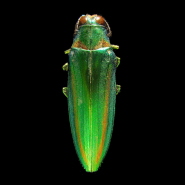An international research team led by a University of Bristol scientist has explained the preservation of colours in fossil insects for the first time.
The discovery explains why colours change and why they are destroyed during fossilisation, revealing hidden gems in the insect fossil record that could help reconstruct the evolution of colours in insects.
The paper has just been published online in the journal Geology. The research will also be showcased at this year’s prestigious Royal Society Summer Science Exhibition in London, from 1 to 7 July.
Many modern insects owe their brilliant colours to microscopic light-reflecting structures in their tissues, but the fossil record of these ‘structural colours’ is patchy. Even where these colours are fossilised, the original colours change during the fossilisation process.

The iridescent jewel beetle Chrysochroa raja owes its colour to nanometre-size structures in its outer tissues and was used in fossilisation experiments to explain patterns in the fossil record of colour
Dr Maria McNamara, a Research Assistant in Palaeobiology from the School of Earth Sciences, led a team of researchers from Yale University and University College Dublin which used a novel experimental technique to simulate high pressures and temperatures that are found deep under the Earth’s surface.
The team used modern beetles and discovered that they changed colour during the experiments due to changes in the chemistry and physical architecture of the colour-producing structures in their tissues.
Dr McNamara said: “Our results explain a big mystery in the field of fossil colour. By looking at what happens to structural colours in modern insects during fossilisation experiments, we can now say exactly why and how structural colours change during the burial process. Now we know what key events in the geological history of sediments can cause colour change. This will help us to pin down which fossils show colours that we can trust, and which have been altered.
“Our results also provide compelling evidence for why certain types of structural colours – produced by complex 3D organic crystal lattices called 3D photonic crystals – aren’t found in the fossil record. Rather than simply not being preserved, our experiments show that these structures are really tough and can survive the same burial conditions as other structural colours. This indicates that 3D photonic crystals, which are the most complex colour-producing structures known in nature, evolved extremely recently – within the last few million years.”
The research was carried out at Yale University and was supported by a Marie Curie International Mobility Fellowship through University College Dublin, awarded to Dr McNamara.
research work: ‘The fossil record of insect colour illuminated by maturation experiments’, by Maria McNamara, Derek Briggs, Patrick Orr, Neal Gupta, Emma Locatelli, Lin Qiu, Hong Yang, Zhengrong Wang, Heeso Noh and Hui Cao published in Geology.



 March 4th, 2013
March 4th, 2013  Riffin
Riffin  Posted in
Posted in  Tags:
Tags: 